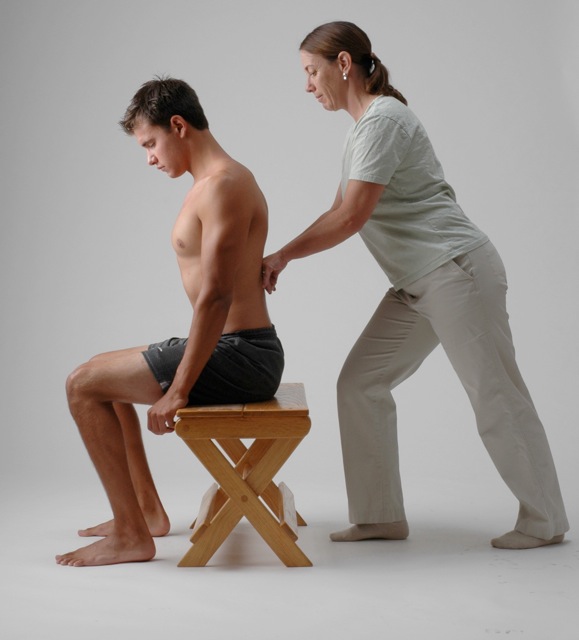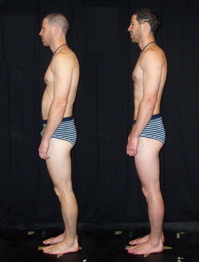 I was recently interviewed by reporter Marissa Capodanno for an article about bodywork modalities she wrote for www.ivillage.com. (Update 4/25/16: It looks like the URL www.ivillage.com now redirects to www.today.com. Therefore the original article seems to have vanished.) The slideshow turned out well with Rolfing SI being featured in its very own slide. However, due to space limitations, much of the interview was not included in the piece. I thought I would publish the full interview here on www.RedwoodEmpireRolfing.com because many of the questions I answered are of interest to people who are unfamiliar with Rolfing SI. It seems like a good thing to make this information available to the public.
I was recently interviewed by reporter Marissa Capodanno for an article about bodywork modalities she wrote for www.ivillage.com. (Update 4/25/16: It looks like the URL www.ivillage.com now redirects to www.today.com. Therefore the original article seems to have vanished.) The slideshow turned out well with Rolfing SI being featured in its very own slide. However, due to space limitations, much of the interview was not included in the piece. I thought I would publish the full interview here on www.RedwoodEmpireRolfing.com because many of the questions I answered are of interest to people who are unfamiliar with Rolfing SI. It seems like a good thing to make this information available to the public.
What is Rolfing SI? What is the underlying philosophy behind it?
This is the simplest analogy I can give you. You know how when you get in a car accident, bend the frame on your car, and have to take it to the auto body shop to get it straightened out? That’s what Rolfing practitioners do for the human body.
Rolfing SI is somatic education the main purpose of which is to improve the structure and alignment of the body. It is not a form of massage therapy. Rather, Rolfing practitioners are the structural experts of the human body. We use skillful hands-on techniques as well as movement education to empower clients to take charge of their own physical and emotional health.
How specifically does it differ from massage therapy? What is the process like? What can someone trying Rolfing SI for the first time expect?
Ida Rolf, Ph.D. created a 10 step process whereby the practitioner systematically works through the entire body to bring it to a higher level of order both structurally and functionally. Rolfers address whole body patterns. A client may come in with an issue in a specific area, but instead of just focusing on “the problem” intelligent evaluation is done to figure out what is happening structurally the may have caused the issue.
For example, in repetitive strain injuries of the wrist, evaluating and educating the client on how to sit in a supported way is essential. Looking at what is happening higher up the muscular chain of connection to the elbow, shoulder, neck and indeed the entire ribcage and spine is essential to create lasting change for the client.
 Some specific differences with massage therapy are that a structural evaluation is done at the beginning of every session to observe structural patterns and set goals for the session. Usually this is done with the client in their underclothes, but it can also be done in a bathing suit or shorts. This allows the practitioner to clearly see the structure of the body. I personally also take time during this part of the session to educate my clients about their patterns so we can begin to create awareness which ultimately leads to long-term change.
Some specific differences with massage therapy are that a structural evaluation is done at the beginning of every session to observe structural patterns and set goals for the session. Usually this is done with the client in their underclothes, but it can also be done in a bathing suit or shorts. This allows the practitioner to clearly see the structure of the body. I personally also take time during this part of the session to educate my clients about their patterns so we can begin to create awareness which ultimately leads to long-term change.
Rolfing practitioners do not use a lot of oil or lotion to glide over the skin as in massage therapy. To access and effect change in the deeper layers of connective tissue it is necessary to have a little traction on the skin.
Rolfers work with clients in different positions than you would see in a typical massage. Practitioners will frequently work with the client in a sidelying position. We will also work with the client “in gravity” which means while sitting on an adjustable height Rolfing bench or even while standing.
In general, Rolfers ask clients to more actively participate in a session than you would see in typical massage which is passively received. We will ask the client to change positions more frequently, stand up for more structural and functional evaluation, or make slow precise movements while we manipulate their tissues. These things helps facilitate the change and awareness process for the client.
What are the benefits? Are there any risks? What precautions should someone take who is considering Rolfing SI?
Rolfing SI has the ability to dramatically alter a person’s posture and structure. Rolfing SI can potentially resolve discomfort, release tension and alleviate pain. Rolfing SI aims to restore flexibility, revitalize your energy and leave you feeling more comfortable in your body.
Athletes, dancers, children, business professionals, and people from all walks of life have benefited from Rolfing SI. People seek Rolfing SI as a way to ease pain and chronic stress, and improve performance in their professional and daily activities. It is estimated that more than 1 million people have received Rolfing SI.
Research has demonstrated that Rolfing SI creates a more efficient use of the muscles, allows the body to conserve energy, and creates more economical and refined patterns of movement. Research also shows that Rolfing SI significantly reduces chronic stress and changes in the body structure. For example, a study showed that Rolfing SI significantly reduced the spinal curvature of subjects with lordosis (sway back); it also showed that Rolfing SI enhances neurological functioning.
Make sure you see a qualified practitioner. That means someone who is trained and certified through The Rolf Institute® of Structural Integration, or a Board Certified Structural Integrator(CM), or at least a professional active member of the International Association of Structural Integrators. Watch this video from The Rolf Institute® of Structural Integration called Balancing the Body to get a good idea of how Certified Rolfers work with clients, and what a Rolfing session looks like.
The usual precautions apply as with any form of hands-on manual therapy. Care should be taken with people at risk of embolism or thrombi from atherosclerosis or varicose veins, and certain autoimmune diseases if in an active phase such as lupus, scleroderma and psoriatic arthritis. People with loss of sensation from diabetic neuropathy or other nerve damage need special attention from the practitioner when receiving work. The same holds true for people with blood clotting issues or who are taking anti-coagulants. There is much research being done on whether it is safe to work with someone when they have cancer. This is a big discussion which I will not delve into here. It is generally a good idea if someone is actively working with an oncologist that they receive approval from their physician.
When would you recommend Rolfing SI?
For relief of musculoskeletal pain which can come from many different causes. For people who are worried about their posture and recognize they would like to have better posture. For people who are on a path of personal development and want to increase their self-awareness. To enhance athletic performance and support yoga, pilates and other mindful movement practices. See also the benefits listed above.
When should someone avoid it?
Acute intervertebral disc problems, during the first trimester of pregnancy, no active work on broken bones, and post-surgery after approval from the attending physician.
Note: As a resource for the precautions and contraindications listed in this article I used Contraindications and Cautions for Deep Bodywork 9th edition, May 2008. This article is written by Robert Schleip, Ph.D., Til Luchau and John Schewe all of whom are Rolf Institute Faculty.
© Carole LaRochelle, 2010.



Many of your links don’t work; I tried to find practitioners you recommended.
Hi Cat, I have updated the links. I found that http://www.ivillage.com now redirects to http://www.today.com. Also, The Rolf Institute has a new website so the links needed to be fixed. Thanks for letting me know.
It is well filmed and edited. It really shows what a Rolfing session actually looks like. I wish we had one this good in English. I have not run across it yet. It is an interesting juxtaposition to watch the video without understanding the language. I like the way it makes me focus on what is going on, instead of listening to words. We’ll keep working on getting a good English language demo video. It requires a script and someone to give us their permission to be filmed in their underwear as a client. Not such an easy thing to get as you may imagine. 🙂
Well Done.
Thanks, Meryl. This feels really good to put the entire interview out there. And thank you so much for tweeting it too!